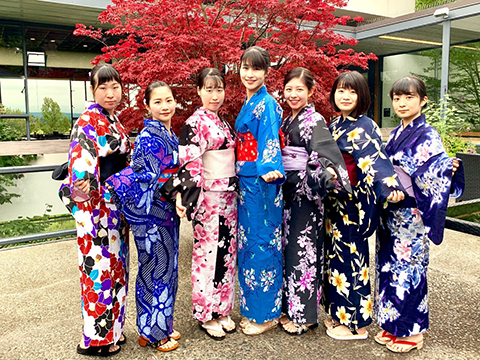国際・国内交流
松尾 麻紗子さん(第5学年次)
ワシントン大学での研修を終えて
2019年8月3日から10日、シアトルで研修させていただきました。到着したのは土曜日で、土日は観光、月曜から木曜は講義や施設見学をしました。個人の旅行では体験できない経験ばかりでした。
今回のテーマはBioethicsです。1日目はワシントン大学での講義が3コマあり、その後Seattle Children’s hospitalで講義と施設見学をしました。2日目はSeattle Cancer Care Allianceで2コマの講義と施設見学をしました。その後ホスピスに移動し講義を受けました。 3日目はNorthwest Kidney Centerでの2コマの講義と施設見学、Harborview Medical Centerでの2コマの講義と施設見学をしました。 4日目はワシントン大学で4コマの講義を受けました。その中から印象に残った講義について述べたいと思います。
まず、Dr. McCormickの生命倫理についての講義です。「Four Box Method」は症例を4つの観点で分類する方法です。その4つとは医療的な情報(Medical Indications)、患者の意見(Patient Preferences)、人生で価値のあること(Quality of Life)、背景(Contextual Features)です。背景には宗教や文化的な違いも含まれます。「Four Box Method」を使うことで事実が整理されてどのような治療をしていくのかなどのこれからの方針が考えやすくなります。最初の講義で教えて頂き、後の授業でもよく用いられていました。
次に1日目に訪れたSeattle Children’s hospitalについてです。子供は必ず親が一緒にいるので、病室はほとんどが個室で親も一緒に寝泊まりすることができます。病院の壁紙が森や海などをイメージして作られており、エレベーターにも動物の名前がついていたりして、子供たちが病院の中を楽しく歩くことができる造りになっていると思いました。この病院はシアトルがあるワシントン州だけでなく、他の州からも患者が来ているそうです。ここで、白血病の女の子のお話を聞かせてもらいました。この女の子は二度骨髄移植をしましたが、また再発してしまいました。「Four Box Method」を使って、女の子の意思を尊重した緩和ケアを行うことができたと思います。医者は患者ともその家族ともしっかりと会話をして、患者がしたいことに寄り添うことが大切だと思いました。
次に、アメリカでのホスピスケアについてです。アメリカでホスピスケアを受ける資格のある患者は医者に余命6か月以内と診断された方だけです。ホスピスケアは施設だけでなく自宅や自分の好きな場所で受けることができます。医者や看護師だけでなく、薬剤師や医療ソーシャルワーカーなど様々な医療従事者が関わっています。日本にはないようなスピリチュアルケア(心のケア)を行うChaplainと呼ばれる方も関わっています。また、患者が亡くなった後に家族に対して死別ケアを行うプログラムもあります。
アメリカのホスピスケアは日本のものとはかなり違っているように感じました。日本でホスピスに入るといえばただ死を待つというイメージが私自身ありました。しかし、アメリカのホスピスケアのお話を聞いていると、残された時間を自分がやり残したことをするのに使い、とても充実しているように感じました。それが実現できるのは患者が死と向き合って、医者や家族ともしっかりコミュニケーションをとるからだと思います。日本人は死についてあまり話したがらないですが、怖がらずに話し合いすることで、よりよい終末期を過ごせるようになるのではないかなと思いました。
講義以外にも、日曜日にはPike Place Marketに行ったり、ショッピングセンターでお買い物する時間もありました。講義もして下さったKing先生のお宅でホームパーティーに招いて頂いた日もありました。ディナークルーズで見た景色はとても素晴らしかったです。朝早く起きて皆でスターバックスの1号店に行った日もありました。ワシントン大学の図書館はハリーポッターのような世界観があり、無理をして昼休みに皆で行った甲斐がありました。
最終日のFarewell-Thank you dinnerでお茶のお点前を披露させてもらいました。以前からお茶を習っていたこともあり、この研修でお世話になった先生方に感謝の気持ちを込めて、学生の代表でお茶を立てました。とても緊張しましたが、美味しかったと言っていただき、日本の文化も知って頂くことができて良かったです。
最後になりますが、この1週間で異文化に触れ、様々な方のお話を聞くことができて、こんな経験は二度とできないだろうなと思いました。今回の研修にご尽力して頂いた山西先生、関先生、我聞先生、近藤先生、中村先生には感謝申し上げます。McCormick先生、King先生を始め講義して下さった全ての先生方、通訳の方にも感謝申し上げます。サポートしていただいた枚方療育園のスタッフの方々にも感謝の気持ちでいっぱいです。
本当にありがとうございました。
